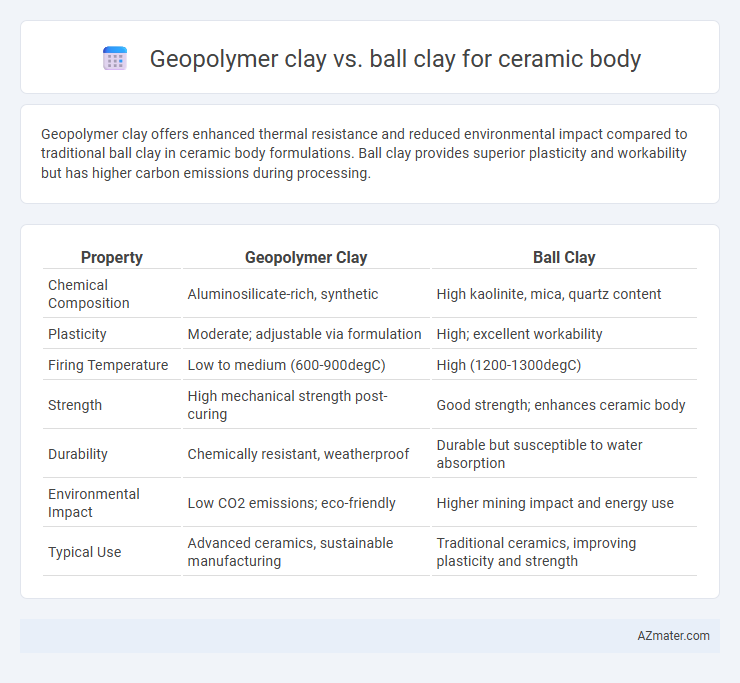Geopolymer clay offers enhanced thermal resistance and reduced environmental impact compared to traditional ball clay in ceramic body formulations. Ball clay provides superior plasticity and workability but has higher carbon emissions during processing.
Table of Comparison
| Property | Geopolymer Clay | Ball Clay |
|---|---|---|
| Chemical Composition | Aluminosilicate-rich, synthetic | High kaolinite, mica, quartz content |
| Plasticity | Moderate; adjustable via formulation | High; excellent workability |
| Firing Temperature | Low to medium (600-900degC) | High (1200-1300degC) |
| Strength | High mechanical strength post-curing | Good strength; enhances ceramic body |
| Durability | Chemically resistant, weatherproof | Durable but susceptible to water absorption |
| Environmental Impact | Low CO2 emissions; eco-friendly | Higher mining impact and energy use |
| Typical Use | Advanced ceramics, sustainable manufacturing | Traditional ceramics, improving plasticity and strength |
Introduction to Geopolymer Clay and Ball Clay
Geopolymer clay offers a sustainable alternative to traditional ball clay, utilizing aluminosilicate materials activated by alkaline solutions to create a durable ceramic matrix with enhanced mechanical properties. Ball clay, primarily composed of kaolinite, mica, and quartz, provides excellent plasticity and fine particle size, which contribute to workability and smooth texture in ceramic bodies. The choice between geopolymer and ball clay influences the final ceramic's strength, thermal resistance, and environmental footprint.
Chemical Composition Comparison
Geopolymer clay primarily consists of aluminosilicate materials rich in silicon dioxide (SiO2) and aluminum oxide (Al2O3), with lower levels of fluxing agents compared to ball clay, which contains higher amounts of kaolinite and organic impurities contributing to plasticity. Ball clay exhibits significant proportions of quartz, mica, and illite, impacting its refractory properties and firing behavior, while geopolymer clay's synthetic nature allows for more controlled chemical composition, optimizing thermal stability and mechanical strength in ceramic bodies. The distinct variation in mineralogy between geopolymer and ball clay influences water absorption, shrinkage, and vitrification, making chemical composition a critical factor in selecting clay for specific ceramic applications.
Processing Differences in Ceramic Bodies
Geopolymer clay requires alkaline activation and curing at relatively low temperatures, leading to a different setting mechanism compared to ball clay, which undergoes traditional drying and firing processes. Ball clay's high plasticity allows for easier shaping and forming, while geopolymer clay demands precise control of chemical reactions during mixing to achieve desired strength and durability. Processing geopolymer clay also involves managing geopolymerization kinetics, whereas ball clay processing focuses on moisture content and particle size distribution for optimal workability.
Physical and Mechanical Properties
Geopolymer clay exhibits higher compressive strength and improved thermal stability compared to ball clay, making it suitable for advanced ceramic body formulations. Ball clay provides superior plasticity and workability due to its fine particle size and mineral composition, enhancing shaping and molding processes. The lower porosity and higher density of geopolymer clay contribute to better mechanical durability and reduced water absorption in ceramic products.
Workability and Plasticity
Geopolymer clay offers enhanced workability due to its synthetic binder structure, allowing easier shaping and reduced cracking compared to traditional materials. Ball clay provides superior plasticity because of its fine particle size and high kaolinite content, making it ideal for detailed ceramic body formation. While ball clay's natural plasticity ensures smooth molding, geopolymer clay's customizable composition supports consistent workability in diverse ceramic applications.
Firing Temperature and Maturation
Geopolymer clay typically matures at lower firing temperatures, around 700-900degC, offering energy efficiency and reduced shrinkage, while ball clay requires higher firing temperatures between 1100-1300degC to achieve full vitrification and strength. The maturation of geopolymer clay results in a dense, chemically bonded ceramic matrix without relying on traditional sintering, contrasting ball clay's maturation through particle fusion and glass phase development. Due to these differences, geopolymer clay is advantageous for low-temperature ceramics, whereas ball clay is preferred for high-strength, traditionally fired ceramic bodies.
Environmental Impact and Sustainability
Geopolymer clay significantly reduces environmental impact by utilizing industrial by-products like fly ash and slag, decreasing reliance on virgin materials and lowering carbon emissions compared to conventional ball clay mining, which involves extensive land degradation and resource depletion. Ball clay extraction often leads to habitat destruction and high water usage, whereas geopolymer clay production incorporates waste materials, promoting circular economy principles and reducing landfill waste. Sustainable ceramic bodies benefit from geopolymer clay's lower energy demand during firing and its contribution to minimizing the ceramic industry's overall ecological footprint.
Cost and Availability Factors
Geopolymer clay offers a cost-effective alternative to ball clay by utilizing industrial by-products like fly ash and metakaolin, which are often cheaper and more abundant than natural ball clay deposits. Ball clay, valued for its plasticity and strength, faces increasing price volatility due to limited reserves and high extraction costs, especially in regions with stringent mining regulations. Availability of geopolymer materials is generally higher in industrialized areas with access to supplementary cementitious materials, making it a more sustainable and economically viable choice for ceramic body formulations.
Suitability for Different Ceramic Applications
Geopolymer clay offers superior thermal resistance and chemical durability, making it ideal for high-temperature ceramics and technical applications such as refractory bricks and industrial ware. Ball clay, known for its excellent plasticity and fine particle size, is preferred in traditional ceramic bodies for products like sanitary ware, tableware, and tiles, where workability and surface finish are critical. Selecting between geopolymer and ball clay depends on the intended ceramic use: geopolymer excels in advanced, engineered ceramics, while ball clay suits conventional pottery and functional ceramics requiring moldability and smooth texture.
Conclusion: Choosing the Right Clay for Ceramics
Selecting the right clay for ceramic bodies hinges on the intended properties and application. Geopolymer clay offers enhanced thermal resistance and sustainability benefits, making it ideal for advanced ceramics and eco-friendly projects. Ball clay provides excellent plasticity and workability, suited for traditional ceramics requiring fine detail and smooth surfaces.

Infographic: Geopolymer clay vs Ball clay for Ceramic body
 azmater.com
azmater.com